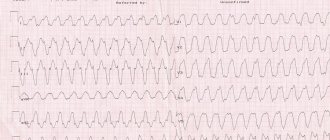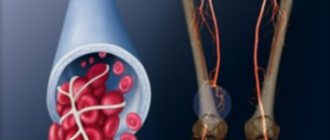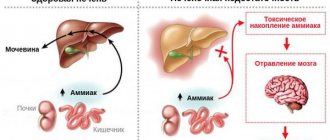Many people have probably heard sad stories about someone’s sudden death due to a broken blood clot. Almost everyone understands that a “severed blood clot” is something life-threatening, but at the same time, not everyone knows what a blood clot is, when it forms and in general why and where it “breaks off”. Therefore, now we’ll talk about blood clots and their role in the body.
Causes of thrombosis
The main cause of arterial thrombosis is atherosclerosis, in which clots of fats or calcium compounds form on the walls of the arteries. They narrow the artery and can completely block blood flow or break off and block smaller vessels.
The development of arterial thrombosis in the vessels of the brain results in strokes, and in the coronary arteries - myocardial infarction.
There are many more reasons for the formation of venous blood clots:
- varicose veins of the lower extremities;
- loss of mobility, both complete and partial;
- bone fractures;
- hypercoagulability and other autoimmune disorders;
- heredity.
Diagnosis of a blood clot in the heart
Typically, in cases of suspected cardiac thrombosis, laboratory and instrumental tests are put into operation. Based on the results, the doctor draws conclusions and prescribes treatment.
Among the instrumental methods they are popular:
- Ultrasound examination of the heart.
- Ultrasonographic examination of the abdominal cavity.
- Echocardiography.
- Radiography. It is necessary to exclude myocardial muscle hypertrophy, aneurysm, demonstration cardiomyopathy and thrombolites.
- Scintigraphy, which helps to see vascular disorders and their location, shows the percentage of myocardial filling.
- Doppler ultrasound, which measures the direction and speed of blood flow as the heart shrinks, shows the pressure in the heart.
- MRI. With its help you can recognize cancer and determine the functionality of the myocardium.
Mechanism of thrombus formation
The formation of a blood clot always follows one scenario: first, damage occurs (trauma to the vessel wall), platelets rush to the site of damage, which stick together into a strong clot and adhere to the wound. Next, fibrin threads are formed, and the vessel receives a “patch.” Over time, the tissues are restored, the blood clot dissolves as unnecessary.
A useful mechanism that saves people from blood loss due to injury can become dangerous when there is an excess of platelets - thrombophilia. An excess of these blood cells results in blood clots that are too large for minor injuries. The second important factor in thrombus formation is the very presence of damage. Thrombosis becomes a pathology if it begins in the absence of injury to the vascular wall.
Antithrombotic nutrition
To prevent thrombosis, the diet should be designed in such a way as to normalize the balance of lipids and carbohydrates, adjust the amount of salt and introduce bioflavonoids into the daily diet, which improve metabolism, strengthen and restore the walls of blood vessels.
Recommended products: lean meat, fatty sea fish, vegetable oil, fresh low-fat milk, low-fat fermented milk products, cereals (except wheat and pearl barley), durum pasta, whole grain bran bread, vegetables (except potatoes and sugar beets), legumes, fruits (except bananas and grapes), nuts, freshly squeezed juices, dark chocolate.
Products that need to be reduced to a minimum: fatty meat and offal, hard and soft fatty cheeses, full-fat dairy products, butter and combined fats, smoked meats, sausages, dried and salted fish, chips, fast food, alcohol, lemonade, candy , milk chocolate, baked goods, potatoes, fatty sauces.
The daily amount of salt should be no more than 6 grams. 1/3 animal protein should account for at least 2/3 vegetable protein and fiber. To prevent thrombosis, you need to add vitamins: C, E, A (retinol), B3 (rutin), bioflavonoids (quercetin, hesperidin).
Be sure to follow the drinking regime: the daily norm for an adult is from 1.5 to 2.5 liters of water per day (soups, tea and coffee are not included here). These simple tips are relevant not only for patients with thrombosis, but also for people with risk factors for this disease. Always be hematologically healthy, and if you identify symptoms of thrombosis, do not self-medicate - contact an experienced specialist, a hematologist-hemostasiologist!
Risk area
The risk of developing vein thrombosis increases with:
- hormonal therapy;
- presence of deep vein thrombosis in relatives;
- pregnancy;
- injury to veins during operations, fractures, cuts;
- physical inactivity;
- increased blood clotting;
- use of venous catheters;
- obesity;
- oncology;
- heart and lung diseases.
Arterial thrombosis is more likely to develop:
- for diabetes;
- high blood pressure;
- obesity;
- low activity;
- bad heredity;
- poor nutrition;
- high levels of bad cholesterol;
Older age increases the risk of both types of thrombosis.
How to prevent a blood clot from breaking off
People whose blood relatives suffered from thrombosis will have a high risk of developing a similar disease. Therefore, you should be regularly examined by a doctor to detect dangerous vascular growths. Modern medicine has all the necessary tools to detect a blood clot and prevent its rupture.
If a person’s blood has increased clotting, he will be prescribed medications (antiplatelet agents). Sometimes they need to be taken for life. It should be noted that only a doctor can recommend them, otherwise you can cause serious harm to your own health.
If the doctor diagnoses a blood clot that is highly likely to break off, the patient is urgently hospitalized and prepared for surgery.
People with thrombosis should strictly follow their doctor's instructions. They are not recommended to take a hot bath, visit saunas and steam baths, as all these procedures increase blood flow through the vessels. A ban is also imposed on visiting massage rooms and using warm compresses.
To prevent blood from stagnating in the veins, it is necessary to move as much as possible, engage in physical exercise, and walk a lot.
If the patient is at risk of blood clot rupture, then strict bed rest is indicated. Self-treatment of thrombosis or wait-and-see tactics in this case is unacceptable.
A menu containing foods that lower blood cholesterol should be a priority. This will prevent the formation of atherosclerotic deposits on the vessels, and therefore reduce the risk of thrombosis. For this purpose, you can include sea fish, seafood, broccoli, spinach, new potatoes, and dairy products in your diet.
Types of thrombosis
The two main types of disease are arterial and venous, but there are two large groups of patients that require more detailed consideration. Many doctors distinguish these variations into separate types of thrombosis.
- Superficial vein thrombosis, or SVT, is when a blood clot blocks the superficial veins of the upper or lower extremities. Accompanied by a characteristic pattern of a darkened vein, its obvious relief. About 10% of cases of TPV, for which treatment was not started, result in serious complications, including tissue necrosis.
- Deep vein thrombosis, or DVT, occurs when a blood clot blocks the deep veins in the lower extremities or pelvis. Causes blood stagnation in the lower extremities, reduces the flow of oxygen-free venous blood to the heart, and significantly increases the risk of pulmonary embolism.
Features of the location of blood clots in the atria
Symptoms may indicate which side the clot is on. Location in the atrium causes fainting, dizziness, arrhythmia, tachycardia. Right heart thrombosis causes shortness of breath, shortness of breath, pale or blue skin, and cyanosis.
Depending on the composition and location, clots can be:
- Hyaline, when proteins are present but fibrin is not present. Most often found in small vessels.
- Red because they contain a lot of red blood cells. Mainly located in veins.
- White, containing fibrin, platelets, leukocytes. They are most often found in the arteries.
The heart clot is usually multi-colored as it is a mixture of all these types. The head consists of a white blob, the body is a mixed area, and the tail is a red blob.
The clot can be mobile or stationary. In the first case, it moves freely between the ventricles and atria. If the clot is immobile, it has a polyp-like stalk that is attached to the endocardium.
Deep vein thrombosis: causes, clinical picture, treatment
The mechanism of blood clot formation allows you to quickly cope with vascular damage, but sometimes the blood clotting process is disrupted, and blood clots occur without external influence, creating a risk to health and life. Deep vein thrombosis most often occurs:
- in older people;
- in patients after laparoscopy or surgery on large joints;
- with severe physical inactivity;
- after fractures and ruptures of internal organs (accidents, fights, etc.);
- during pregnancy and childbirth - in pregnant women, blood clotting is increased;
- with long-term use of oral contraceptives;
- in smokers.
The main symptom of DVT, which occurs when the blood clot is located above the lower leg, is swelling and pain in the affected limb.
Thrombosis factors
An increased risk of blood clots is caused by:
- Genetic inheritance to predisposition.
- Diseases that force you to limit physical activity, for example, bed rest.
- High degree of blood clotting.
- Arrhythmia, cardiomyopathy and other diseases that disrupt the strength and rhythm of blood flow throughout the system.
- Varicose veins.
- Liver dysfunction.
- Alcoholism.
- Smoking.
- High body mass index.
- Age-related changes in hormone levels in both men and women.
Some of these factors cannot be influenced, for example, genetic predisposition. However, you can protect yourself from the serious consequences of blood clots by maintaining an active and healthy lifestyle.
General symptoms of thrombosis
The disease is quite difficult to identify in the early stages, but there are a number of signs that should alert the patient:
- swelling of the limbs in the evening;
- the appearance of a network of dilated vessels;
- fast fatiguability;
- sudden lameness after exercise;
- cold extremities;
- difficulty breathing;
- pain in the chest and back after stress and physical activity;
- dizziness and tinnitus;
- problems with coordination of movements;
- bloating, indigestion. abdominal pain without clear localization.
Since the primary signs of thrombosis can also be a consequence of other diseases, a complete diagnosis of the body is necessary. The localization of problematic sensations is not always directly related to the area of thrombus formation. For example, dizziness can also occur with damage to the coronary arteries - due to tissue hypoxia.
Specific signs of a blood clot
If treatment of the disease is not started in the early stages, more distinct signs appear that make it possible to recognize a blood clot:
| Type of thrombosis | Symptoms |
| Deep veins of the leg | cold hands or feet, fatigue, low exercise tolerance, intermittent claudication after a long walk |
| Pulmonary artery | Sudden onset of shortness of breath, bluish skin with a gray tint, drop in pressure, chest pain, heart rhythm disturbances, bulging neck veins, fainting, cough, wheezing, pinkish sputum, increased body temperature, pain in the right hypochondrium. |
| Coronary arteries of the heart | Pain behind the sternum, radiating to the back and neck, occurs during stress, physical activity, and is accompanied by shortness of breath and rapid heartbeat. |
| Arterial network of the legs | Chilliness, numbness of the feet, burning, pain when walking, which stops when you stop, the skin becomes pale, and then the fingers turn blue. |
| Cerebral arteries | Dizziness, unsteadiness, various visual disturbances, unclear speech, decreased muscle strength and sensitivity in the arm and leg, memory loss. |
In general, the main symptoms of extremity vein thrombosis are:
- swelling;
- heaviness in the arms or legs;
- fatigue;
- redness and swelling of the skin in the area of the blood clot;
- pain on palpation along the vein;
- local temperature increase.
Thrombosis of deep veins and internal vessels is much more difficult to determine; as a rule, the patient learns about them from the doctor, and the initial complaint may not have any connection with the formation of a blood clot.
When to see a doctor
The patient’s subjective sensations are extremely important for timely diagnosis of the disease. That is why you should not delay seeing a doctor if:
- there was a feeling of fullness in the legs when walking;
- the limbs are decorated with vascular mesh;
- often the heart hurts or the left side of the body goes numb - angina pectoris;
- there were sudden problems with vision, hearing, diction, swallowing, coordination;
- cough, shortness of breath, chest pain, weakness appeared;
- the kidneys or one kidney are sick. There was blood in the urine.
It is worth noting that a timely visit to a doctor with such signs can protect patients from heart attack, stroke, pulmonary embolism and other complications with high mortality.
Then you will find out...
2/3 of venous thrombosis are asymptomatic or with mild symptoms. A person is bothered by moderate pain in the leg and slight swelling, but not so severe as to force him to see a doctor. Of the three cases of thrombosis, one progresses, and two resolve spontaneously.
However, this does not always mean that resolved thrombosis has passed without a trace. Even in this case, irreversible changes occur on the wall and valve of the affected vein, which lead to the development of chronic venous insufficiency. With duplex scanning of blood vessels, doctors often see post-thrombotic changes in the deep veins of the leg in patients who have never been diagnosed with venous thrombosis.
Blood control and nutrition without “greens”. A doctor on how to live with thrombosis Read more
What can a doctor do?
Depending on the severity of the condition, the doctor may:
- Order a test for thrombophilia.
- Prescribe Doppler examination of blood vessels.
- Prescribe an ultrasound of the veins.
- Refer to a more specialized specialist - with DVT to a phlebologist, with intestinal vein thrombosis - to a gastroenterologist, with a threat of coronary artery thrombosis - to a cardiologist.
- In severe cases, ensure urgent hospitalization.
- If you detect a blood clot that has not yet come off, completely covering large vessels, or if the blood clot breaks off, insist on surgical intervention.
- If a blood clot is diagnosed early, conservative treatment should be prescribed. For example, the drug Fazostabil has proven itself well as a means of promoting the resorption of blood clots and preventing their re-formation.
In addition, the specialist will be able to identify other diseases that can produce similar symptoms and prescribe appropriate treatment.
So, what is next?
At the first suspicion of thrombosis, you should consult a doctor. In acute cases, the patient is immediately sent to the operating table for vein ligation, installation of a vena cava filter, or surgical removal of a blood clot. But more often thrombosis is treated on an outpatient basis. The doctor will conduct an initial diagnosis, confirm the conclusion with an ultrasound examination (duplex scanning of veins) and prescribe anticoagulants - blood thinners, the task of which is to clear the lumen of the vessel. Be patient! The duration of taking anticoagulants can range from 3 months to conditionally lifelong use. And all this time you will need to visit the clinic so that the doctor evaluates the effectiveness (lack of relapse), safety (lack of bleeding) of therapy and determines the required duration of treatment.
If the blood clot comes off
The thrombus is not always firmly attached to the wall of the vessel. When a clot is superficially attached, a simple surge in pressure, a blow, or a careless movement is enough for the clot to come off and travel through the circulatory system. Moving through the vessels, the detached thrombus sooner or later reaches the most important organs, and usually the pulmonary vein, if the thrombus was venous, or the left atrium, if arterial.
Pulmonary thrombus
In the most dangerous cases, blockage of the large vessels of the lung occurs, after which death occurs within a few minutes. A less severe option is infarction-pneumonia, when a blocked vessel bursts and the lungs begin to fill with venous blood, which is accompanied by acute pain and hemoptysis. In this case, the patient has every chance of survival.
The mildest case, when a blood clot enters the pulmonary veins, is accompanied by an increase in blood pressure in the lungs, pain, shortness of breath, and suffocation. If you call an ambulance right away, the patient is likely to survive.
Coronary thrombus
If a blood clot located in the left atrium or coronary arteries breaks off, the patient is at risk of: myocardial infarction, stroke if the blood clot enters the brain through the bloodstream, infarction of the intestines or kidneys if the arteries leading to them are blocked, as well as blood stagnation and gangrene with subsequent loss limbs if the blood clot gets into the large arteries of the arm or leg.
First aid
If you notice the first signs of a clot dislodging, you must urgently call an ambulance, since it is impossible to provide professional help at home. The team will immediately start you on anticoagulants such as heparin. Enoxaparin, Nadroparin, Dalteparin. You should not inject them yourself as this may cause serious bleeding.
To get rid of existing clots, the patient is prescribed fibrinolytic drugs. These are: fibrinolysin, thromboflux, streptokinase. If necessary, the clot is removed with a catheter. If the patient falls into a coma, artificial ventilation and cardiac arrest.
Chances of helping the victim
Saving a person with a violin clot is only possible with timely help. A general blockage of the vessel can cause death within minutes.
Treatment of thrombosis
Treatment of thrombosis requires an integrated approach. There are modern techniques that allow you to dissolve a blood clot by introducing special drugs directly into the vessel. This method is justified in cases of immediate threat to life, since it prevents blood clotting for a long time and makes any injury dangerous.
More conservative methods involve the use of compression hosiery, installation of a vena cava filter to catch blood clots, as well as a number of drugs based on acetylsalicylic acid - they help restore normal blood clotting.
The duration of drug therapy is determined by the doctor.
Folk remedies in the treatment of thrombosis
In the treatment of thrombosis, folk remedies that provide thrombus resorption or thrombolysis can be used in parallel with medications. As a rule, doctors recommend:
- Turmeric, which contains curcumin, which helps dissolve blood clots.
- Garlic contains sulfur compounds that are effective in combating clots.
- Peppers: red, chili, hot - contain salicylates and protect against the formation of new blood clots.
- Flaxseed is a storehouse of Omega-3s that improve blood circulation. In combination with fatty red fish, they not only reduce the risk of thrombosis, but also increase the elasticity of the walls of blood vessels.
- Peppermint infusion helps lower blood pressure, reduce blood clotting, and dissolve newly formed clots.
The use of folk remedies must be coordinated with your doctor, since too much blood thinning can lead to internal bleeding and even death!
Prevention of thrombosis and re-formation of blood clots
A number of factors that provoke the formation of blood clots do not depend on the individual, however, even in the case of autoimmune disorders and hereditary predisposition, the risk of thrombosis can be reduced.
- Movement. Stagnation of blood due to a sedentary lifestyle contributes to damage to the veins, so you need to walk, walk, and play active games.
- Nutrition. The development of atherosclerosis and arterial thrombosis is facilitated by the abuse of trans fats, fast carbohydrates, bad cholesterol, alcohol, etc. Switching to a healthier diet will reduce your risk of developing many diseases.
- Wearing compression stockings. Recommended for pregnant women, people with varicose veins, as well as during and after operations. The degree of compression is determined by the doctor.
- When immobile for a long time, for example, on an airplane, it is necessary to wear loose clothing and take the most relaxed postures. Do not cross your legs to avoid blood stagnation.
- Older patients are recommended to take prophylactic medications that reduce the risk of blood clots.
To avoid re-formation of a blood clot, you should follow your doctor’s recommendations and respond as carefully as possible to all sensations in your body.
How does a blood clot form?
Blood is necessary for a person to live. It circulates through the vessels, delivering nutrients and protective elements to the organs, which help in the fight against viruses and bacteria. If a person is injured, the blood clots, thereby blocking their access to the body. The ability of blood to form clots and clog the lumen of a vessel with them can sometimes play a cruel “joke” on a person, which will lead to disability or even death.
Blood has fluidity so that it can clot at the right moment; the mechanisms of the coagulation system are activated. It triggers the formation of protein fibrin threads, which clog the vessel, preventing excess blood from leaking out.
The human body also has an anticoagulant system that fights the formation of blood clots in those tissues that have not lost their integrity. If at some point there is a malfunction in the functioning of these two systems, then blood clots begin to form in the vessels.
They are located near the inner wall of the vein, going through several stages:
- A blood clot begins to grow in the place where the vessel is damaged and inflamed. Most often this happens against the background of thrombophlebitis. The body reacts to an inflamed vessel by activating the blood coagulation system. It triggers the production of fibrin fibers, which are concentrated near the site of inflammation.
- Red blood cells and platelets begin to become entangled in fibrin fibers.
- New blood cells that are brought in with the bloodstream continue to “stick” to the clot, making it larger and larger. It increases in size, becomes denser and can come off at any moment.
Blood clots can also form in arteries when the vessel narrows. Cholesterol plaques that have grown on the arterial walls are an obstacle to normal blood flow, as a result of which a clot of fibrin threads and platelets begins to grow.
Risk factors for blood clots:
- Belonging to the male gender, over 40 years of age.
- Belonging to the female gender, over 50 years of age. An increased risk of thrombosis is caused by menopausal changes in the body.
- Dehydration of the body.
- A cancerous tumor of a malignant nature.
- Alcohol abuse.
- Serious errors in nutrition.
- Taking certain medications. Hormonal contraceptives pose a particular danger in terms of blood clot formation.
- Postponed surgery.
- Disruption of the normal flow of blood through a vessel as a result of its compression.
- Pregnancy.
- Vein injuries in the legs.
- Heart failure.
- Infections.
Blood clots that form in large vessels pose a danger to human life. Their separation will lead to the rapid death of the patient.









